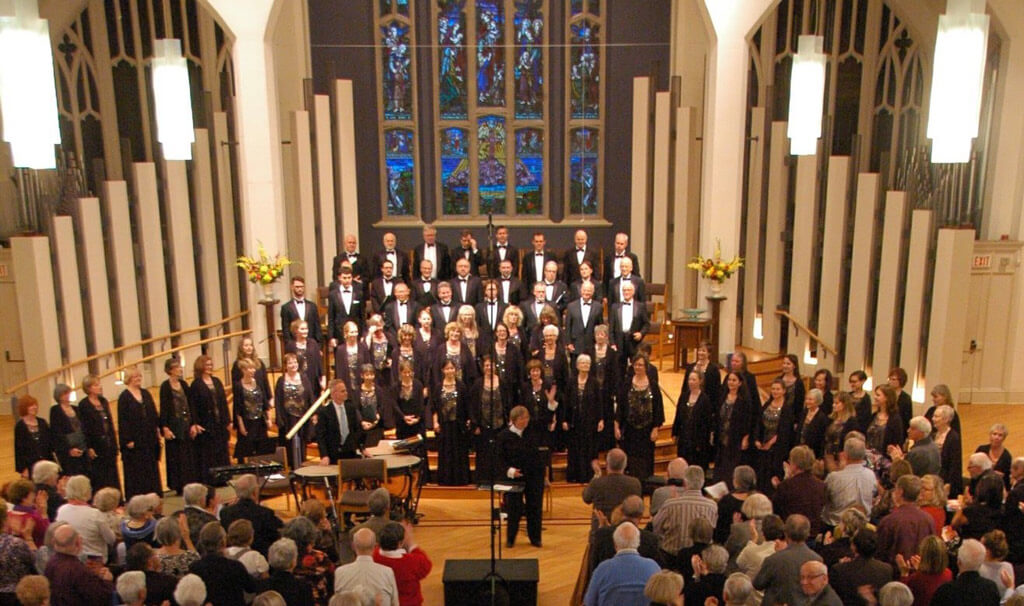
Rehearsal begins: Stéphane Denève hits the downbeat with intense ferocity, his mind and thought already on restraint and control. He understands this work deeply, and his entire body communicates this intention. He brings the sound instantly back, prepping the choir for a soft entrance. The choir flows beneath him, softly invoking a pleading prayer. Lydia Adams, conductor of the Amadeus Choir and the Elmer Iseler Singers, sits intently to the side, watching Maestro Denève massage his message through her choirs. I think they’re well on their way to a stirring performance.
Fauré’s Requiem is a standard rite of passage for any chorister. I asked Lydia Adams of her thoughts on the composition. “It carries in it a sublime truth that instantly strikes the performer and listener. Immediately when you hear it, you know that Fauré has found, in this work, a place of beauty and profound depth, thought and spirituality”, she says. It is frequently programmed and performed with ensembles of various size. The Toronto Symphony Orchestra, Elmer Iseler Singers, and the Amadeus Choir combine their power together to bring this work to life under French guest conductor Stéphane Denève. This is his first time conducting a choral work with the TSO, and I hope it isn’t his last.
The Requiem is a hard sing because it requires such incredible restraint to be performed effectively. The melodies are long and sustained. Phrases stretch over several slow bars, a struggle to keep focus and intention without losing energy and devolving into a pit of mud. Fauré is judicious with his use of anything more than a mezzo-forte throughout the piece. This makes the romance and beauty of his writing ever more clear. The preface of quiet restraint makes the louder sections of the work the more impressive and effective.
Accompanied by the TSO, the Choirs have the advantage of stable, gentle, lines in the strings to help accompany the quiet restraint needed of the piece. The added complexity and the difficult feat of singing with the TSO is overcoming the great space of Roy Thomson Hall.
“Consonants,” is a frequent direction from Denève. He wants pianissimo voice but fortissimo text. Especially in the “Agnus Dei”, the combined Choirs are almost outnumbered by the members of the Orchestra. In the hall, it can be a struggle to hear what they are saying. At almost half the size of the Toronto Mendelssohn Choir (only 60 musicians were requested by Maestro Denève), which equally struggles in the large cavernous hall. Denève’s hope is to have the entire choir in one single line in the choir loft. But he knows, consonants are the only way to energize the lines and bring them across, no matter what dynamic.

“We ask the Lord to grant eternal rest. Imagine, looking in the eyes of whomever… it must feel fresh and childish… [an] intimate prayer.” There is an incredible tension at play with many of the lines. Fortes are marked because there are pianos. “Kyrie” has tension and different intention than the proceeding “Eleison”. Then a different invocation in the same words in the bar after. The “Sanctus” has repetition that must never feel repetitive. Denève describes infinity as repetition. God is offering us paradise in eternity”. He speaks of Bach, fugal runs, counterpoint – it’s all continuous and beautiful, but must never feel repetitive.
The Tenors have a beautiful line after the introduction in the “Kyrie Eleison”. They’re trying too hard, working to be beautiful instead of working to simple. It is the simplicity that Deneve is after.
Denève beckons earlier consonants, setting up the vowels so that the sound is “like a flow of fresh water.” His conducting matches his expression perfectly, a continuous expression of connected, legato singing. The tenors respond accordingly, providing the “infinite line” Denève is looking for. “More life,” he says, “free and easy, not one bit of tension.”
“Preparation is key”, says Denève, “so we know that you are going to say something”. “You must think of this as like your first baby, so fragile, so small, so tender”, says Denève. His interpretation makes the tension of the Faure so incredibly stirring. The energy and intention he brings is exciting and exceptionally vibrant. The Amadeus Choir, the Elmer Iseler Singers and the Toronto Symphony Orchestra will be joined by Canadian Baritone Russell Braun (newly appointed Officer of the Order of Canada) and Canadian soprano Karina Gauvin. With Adam’s preparation and Denève’s baton, the choir is ready to join the TSO for two nights of the Fauré Requiem.
Coming up later in the Amadeus Choir season is Love Notes with special guest Sharon Smith, a jazz favorite. Saturday, February 18, 2017, 7 p.m. Jubillee United Church, Toronto. Later in April, Adams is especially pumped for a feature with Dr Roberta Bondar. “We are all very excited to perform with Dr. Roberta Bondar, our special guest, on this coming April 9th at Eglinton-St .Georges United Church to celebrate both the 25th Anniversary of Dr. Bondar’s flight into space and also put a spotlight on our environment”, she says. The Amadeus Choir presents High Flight. April 9, 2017, 7:30pm. Eglinton-St Georges United Church, Toronto.
The Toronto Symphony Orchestra, the Elmer Iseler Singers, and the Amadeus Choir present Fauré’s Requiem. Wednesday February 1, 2017, 8pm & Thursday February 2, 2017, 8pm. Roy Thomson Hall, Toronto.
[Last Updated: January 31, 2017, 11:00 a.m.]



